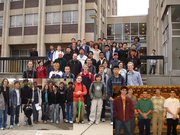06-240/Final Exam Preparation Forum
| ||||||||||||||||||||||||||||||||||||||||||||||||||||||
If you have questions, ask them here and hopefully someone else will know the answer. (Answering questions will probably help you understand it more).
Since many of us (including I) don't really know how to use Wiki's, I suggest that we keep the formatting simple: I will post a template at the top of this page, and if you want to add something just click on the "edit", copy the template, and insert your question. Order the questions according to section (solved/unsolved), with the newest at the top, except for the template question. In general, I wouldn't retype the question if it's from the book because that's tedious and we all have the book.
(By the way, I think you leave a space between lines in the code to make a new line; that is, simply pressing enter once will not make a new line. Also, you can press a button at the top of the math page that lets you put in simple equations.)
Unsolved Questions
Sample Question
Q: Can someone help me prove: "If an integer is greater than 2, then has no solutions in non-zero integers , , and ."? I had the answer in my head at one point, but the margins of the piece of paper I was working with was too small to fit it.
Complex Numbers
Q: If 'C' is used in the context of a vector space (as in "define T:C->C"), then should we consider C to be the vector space of C over the field C, or instead C over the field R?
Sec. 1.6, Ex. 29 a.
Q: Does anyone know an efficient way of doing this?
Sec. 1.3 Thm 1.3 Proof
Q: In the first paragraph of the proof, it says "But also x + 0 = 0 , and thus 0'=0." How do we know 0 (that is 0 of V) even exists in W? I understand that we know some zero exists (0'), but not why the zero (0) exists.
Solved Questions
Question Template
Q: How many ways are there to get to the nth stair, if at each step you can move either one or two squares up?
A: This question can be easily modeled by the Fibonacci numbers, with the nth number being the ways to get to the nth stair. This is because, to get to the nth stair, you can come only from the n-1th or the n-2th. This is exactly how the Fibonacci numbers are defined; the proof is simple by induction.





